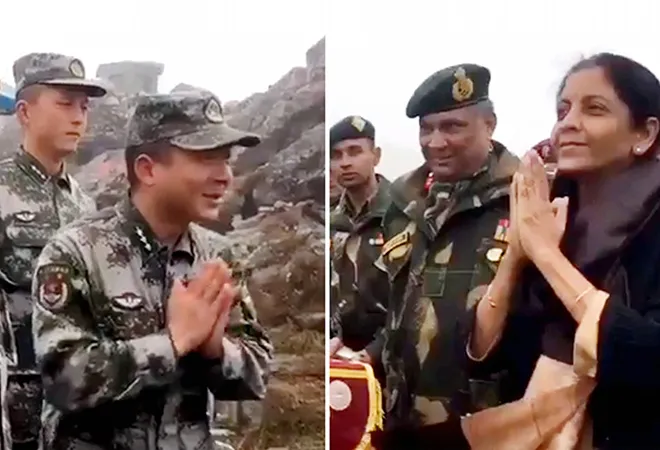
China has gone ‘gaga’ over Defence Minister Nirmala Sitharaman’s unscripted interaction with Chinese soldiers at the India-China border at Nathu-La in Sikkim this month. Those were the recent headlines in the Indian media as the post Doklam honeymoon with China continues. In the moments that were captured on camera, Ms. Sitharaman taught the Chinese soldiers how to say Namaste, a video that soon went viral. As the story hit headlines, so did this: high resolution satellite images showing that China has, for almost 10 years now, been converted tracts of land in the Doklam plateau into all weather roads. A report on NDTV says: “he satellite images show two roads from Doklam which separately lead to the town of Yatung in the Chumbi Valley, where China bases the soldiers that it uses for its operations in the high altitude Doklam Plateau.”
Just over a month after the over 70 day standoff, the worst in decades, was defused, reports have emerged of the Chinese army building a road on the Doklam Plateau again, this one about 10 kilometres from the location of the standoff.
Some 500 soldiers are reported to be there, with the fresh road activity starting shortly after the face off ended on 28 August. However, there has been no sign of any permanent structure. While the Ministry of External Affairs is on record to say that the “status quo” prevails in the “face-off area” since the 28 August disengagement, army officials believe this is Beijing’s way of messaging on its territorial claims.
So, while India handled the Doklam face-off with a great degree of maturity and restraint, and while the photos of the Raksha Mantri saying Namaste to Chinese soldiers may be good PR, India cannot afford to let its guard down. The media must also show maturity how it covers India-China ties.
The media must also show maturity how it covers India-China ties.
Apart from some positive statements on establishing better contact between defence personnel when Prime Minister Modi met President Xi Xinping in Xiamen, in September, for the BRICS Summit, there is no reason to believe the border tensions will stop. In fact, China is very likely to needle India along different parts of the Line of Actual Control or the LAC. India’s tough, unwavering stand, the timing of the BRICS Summit and the Chinese Communist Party’s Congress in mid-October forced the Chinese President’s hand at Doklam.
In an apparent reference to China, last month, Army Chief Bipin Rawat had warned: “As far as the Northern adversary is concerned, flexing of muscles has started. Salami slicing, taking over territory in a very gradual manner, testing our limits or threshold is something we have to be wary about. Remain prepared for situations that are emerging gradually into conflict.”
The Government of India would be wise to take heed of the army’s concerted push now for better infrastructure along the 4,057 kilometres LAC with China. This has been a key focus of a recent conference of army commanders.
The Government of India would be wise to take heed of the army’s concerted push now for better infrastructure along the 4,057 kilometres LAC with China.
Much was made in the Indian media of September’s BRICS declaration, which for the first time, talked about Pakistan-based groups like the Lashkar-e-Taiba, Jaish-e-Mohammed and the Haqqani network, but the context was terror in Afghanistan, not India. A similar declaration had been made at the Heart of Asia conference on Afghanistan in Amritsar in December 2016, in which both China and Pakistan were participants.
The real test of China’s intentions on terrorism will be clear later this month when an application by the US, UK, and France to list Jaish-e-Mohammad chief Masood Azhar as a terrorist comes up for review at the UN Security Council sanctions committee. China has repeatedly blocked attempts by India and others in the part to sanction the Jaish-e's chief.
Interestingly, this year, China has not shared any hydrological data with India on the Brahmaputra and Sutlej rivers, as it is normally supposed to during the flood season from 15 May to 15 October. Under the mechanism established between the two countries in 2006, this data is in fact supposed to be shared by Beijing twice a day. The data is important since China is the upper riparian state and this allows the lower riparian state of India to then take whatever steps are needed to deal with flooding in the Northeast. Government officials in New Delhi have confirmed that no data was shared at all this year, with the Chinese side citing “technical and logistical” problems.
There has also been no progress on India’s membership atthe Nuclear Suppliers’ Group, or the NSG, thanks to Chinese opposition. New Delhi has come a long way from last year, when Foreign Minister Sushma Swaraj confidently declared that India would become a member by the end of the year. Beijing thwarted those plans and India has been wise to keep any outreach on the issue more low key.
There has also been no progress on India’s membership at the Nuclear Suppliers’ Group, or the NSG, thanks to Chinese opposition.. Beijing thwarted those plans and India has been wise to keep any outreach on the issue more low key.
While China is certainly an adversary, would it however be wise to see it as an enemy? That is what former Foreign Secretary and India’s former envoy to Beijing, Nirupama Rao, has argued in a recent piece, where she has called for “a little unemotional pragmatism. Restoring China to enemy status is not a desirable, or sustainable, goal.”
Perhaps it would help if statements from top Indian military officials on “two front wars” could be avoided. The latest from Air Chief Marshal B.S. Dhanoa, who said the Indian Air Force can engage in a two-front war involving China and Pakistan.
In this long-term game with China, “unemotional pragmatism” may be the best way forward. So by all means, cheer when the Defence Minister says Namaste to Chinese soldiers or when a Chinese Univeristy offers the country’s first master’s degree in Yoga, as the Minzu University is now doing. But India needs to strengthen its infrastructure and most of all its economy. That is where the real battle lies.
The views expressed above belong to the author(s). ORF research and analyses now available on Telegram! Click here to access our curated content — blogs, longforms and interviews.




 PREV
PREV


